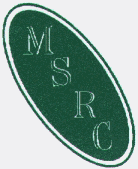Hello, Andrew!
There are probably many people like me with MS, who do not wish to become involved in posting on forums, but who are carefully reading and weighing various options for alternative treatments for better health. The information on other threads about chronic cerebrospinal venous insufficiency in MS and the information that you have provided about Inclined Bed Therapy makes sense to me. I think that I have read through everything you have posted on the internet about IBT, but could not see the YouTube video because I have dialup service. I appreciate your sharing your findings and for your patient perseverance as you try to overcome the “Semmelweis Reflex” you encounter on all sides!
-------------------------------------------------------
In response to your initial questions above:
My mother has varicose veins in her legs; her mother had them; my daughter has them; and they each had surgery on them -- multiple surgeries in the case of my mother and grandmother. Although I am close to 68 years old, I still do not have them.
My upper legs have some spider veins, but not the lower legs -- which seems to be unusual. Twisted veins are visible under the skin, but they do not protrude. However, both legs have spasticity, especially in the lower portion, and it often feels to me that I am walking on wooden stumps below the knee. Perhaps the muscle spasticity is helping to keep the veins from bulging? On the outer aspect of my lower left leg (in the calf area), there is a bluish area about the size of a quarter, which is painful most of the time. When I exceed my limits of physical activity, the pain extends from the knee to the ankle. I do not know whether the pain is due to muscle or vein problems.
Since my teenage years, the veins on my hands have been very large, swollen and protruding. I can remember feeling a little embarrassed to have hands that looked like an old lady’s hands -- like my mother’s! Looking back, early neurological symptoms began to appear around this time, also.
Hemorrhoids -- mild, and perhaps related to childbearing?
---------------------------------------------------------
Since I have experienced more than enough surgeries in my younger years, my priority now is to look for alternative choices to surgeries and drugs.
I tilted my bed on February 20 to see what would happen.
I have no camera, and will be keeping only simple notes of observations.
What I noticed immediately, from the first night, was the change in the color of my urine. For about 38 years, I have been very health conscious and careful to practice good lifestyle habits, including drinking about 72 ounces of water daily (body weight about 118 pounds). This was supposed to produce very pale, straw colored urine, but it never did -- it was always dark colored -- until February 21, 2009. Now my urine output stays very pale and straw colored. Also, when I first awaken in the morning, I no longer need to rush to the bathroom. I can turn over and actually lie in bed for another hour or more before arising, if I so choose!
Beginning after the third night, my back feels different. The spine feels “looser” somehow. The skeletal alignment has improved, and I find that I can now do heavy (for me) physical work without feeling any back pain the next day. This has a negative side to it, because I tend to push my limits a little too far for several successive days to the point where I am so exhausted that I cannot do much of anything for the next few days -- but -- my back does not suffer for it! I find this wonderful and amazing!
These and other simple differences make it worthwhile for me to maintain the inclined bed indefinitely. What began as an experiment is now a lifestyle change. I would not go back to the flat, horizontal sleeping and resting position. As more time passes, there will be more benefits, neurological and otherwise. Of that I am now certain, and I will be watching for them.
You can know that you have helped yet one more person. Thank you, Andrew, for taking the time to share with us what you have learned about Inclined Bed Therapy.
Posted: Sun Apr 26, 2009 1:02 am
Hello, Andrew!
There are probably many people like me with MS, who do not wish to become involved in posting on forums, but who are carefully reading and weighing various options for alternative treatments for better health. The information on other threads about chronic cerebrospinal venous insufficiency in MS and the information that you have provided about Inclined Bed Therapy makes sense to me. I think that I have read through everything you have posted on the internet about IBT, but could not see the YouTube video because I have dialup service. I appreciate your sharing your findings and for your patient perseverance as you try to overcome the “Semmelweis Reflex” you encounter on all sides!
-------------------------------------------------------
In response to your initial questions above:
My mother has varicose veins in her legs; her mother had them; my daughter has them; and they each had surgery on them -- multiple surgeries in the case of my mother and grandmother. Although I am close to 68 years old, I still do not have them.
My upper legs have some spider veins, but not the lower legs -- which seems to be unusual. Twisted veins are visible under the skin, but they do not protrude. However, both legs have spasticity, especially in the lower portion, and it often feels to me that I am walking on wooden stumps below the knee. Perhaps the muscle spasticity is helping to keep the veins from bulging? On the outer aspect of my lower left leg (in the calf area), there is a bluish area about the size of a quarter, which is painful most of the time. When I exceed my limits of physical activity, the pain extends from the knee to the ankle. I do not know whether the pain is due to muscle or vein problems.
Since my teenage years, the veins on my hands have been very large, swollen and protruding. I can remember feeling a little embarrassed to have hands that looked like an old lady’s hands -- like my mother’s! Looking back, early neurological symptoms began to appear around this time, also.
Hemorrhoids -- mild, and perhaps related to childbearing?
Since I have experienced more than enough surgeries in my younger years, my priority now is to look for alternative choices to surgeries and drugs.
I tilted my bed on February 20 to see what would happen.
I have no camera, and will be keeping only simple notes of observations.
What I noticed immediately, from the first night, was the change in the color of my urine. For about 38 years, I have been very health conscious and careful to practice good lifestyle habits, including drinking about 72 ounces of water daily (body weight about 118 pounds). This was supposed to produce very pale, straw colored urine, but it never did -- it was always dark colored -- until February 21, 2009. Now my urine output stays very pale and straw colored. Also, when I first awaken in the morning, I no longer need to rush to the bathroom. I can turn over and actually lie in bed for another hour or more before arising, if I so choose!
Beginning after the third night, my back feels different. The spine feels “looser” somehow. The skeletal alignment has improved, and I find that I can now do heavy (for me) physical work without feeling any back pain the next day. This has a negative side to it, because I tend to push my limits a little too far for several successive days to the point where I am so exhausted that I cannot do much of anything for the next few days -- but -- my back does not suffer for it! I find this wonderful and amazing!
These and other simple differences make it worthwhile for me to maintain the inclined bed indefinitely. What began as an experiment is now a lifestyle change. I would not go back to the flat, horizontal sleeping and resting position. As more time passes, there will be more benefits, neurological and otherwise. Of that I am now certain, and I will be watching for them.
You can know that you have helped yet one more person. Thank you, Andrew, for taking the time to share with us what you have learned about Inclined Bed Therapy.
ForeverSpring
Tue Apr 28, 2009 9:24 am
Hello ForeverSpring
I sent you a pm thank you for your most welcome post, leaving your post at the end of the thread to encourage a few more people to read what you are saying and hopefully test this simple therapy. I wrote in another post it is only a matter of time before some of the people on this forum who have tilted their beds will begin to notice unusual changes, some changes will be obvious, but others will take a while before people remember “hey I don’t have to do this anymore” or “I used to take x amount of minutes to do this”. I am particularly interested in eyesight improvements in people with irreversible optic nerve damage. This has proved if you pardon the pun Spectacular. Two ladies in Devon within a month of each other regained their eyesight after being registered as partially blind. Two ophthalmologists wrote to me within the same month from two different towns asking how blocks of wood under a bed could restore their sight.
Thank you so much for taking the time to understand my reasoning behind this therapy. Many people skim over it and draw an erroneous “this cannot possibly have an effect” conclusion”
Wobbly on this forum wrote;[quote] bed tilting is not gonna work--that much i can say --it might help or after this problem is fixed to maintain the results/ i have seen some of the dopplers this is real blockage
Well Wobbly, had you have seen what I and many others have observed, you might not be so ready to draw such a conclusion about a therapy you have not taken the time to investigate thoroughly. But you are correct in a sense also, because if you never tilt your bed, then of course it can never work.
RE: Urine. This for me was one of the greatest observations ever made using IBT. My own late Father had acute renal failure while in hospital and made to lay flat rather than at an angle as I had been arguing and almost got myself thrown out. Eventually they submitted, well while my back was not turned at least. My Brother, sister in law, wife and myself were told his demise would be rapid, the tar like urine was caused by blood, he had multiple organ failure and would not recover.
When they eventually tilted his bed, within a few hours, his urine became clear, he regained consciousness from being comatose and gained another precious 8 months of life following a stent operation to relieve pressure on his gallbladder caused by cancer, which unfortunately had spread to his liver before he was admitted to hospital.
Indeed, my own experiments and the observations of many people who were testing IBT had enabled me to make the prediction to the doctors that his kidneys had not become irreparably damaged as they insisted was the case. Those 8 months of extra life Dad had enabled him to come to terms with the fact that he had progressive cancer. Even so, I fanatically researched alternatives, for him but Dad, bless him was a hardened stubborn man who would never bend or bow to anyone or anything. I learned that day that IBT cannot give anyone immortality.
This story did not end here but is too painful for me to continue, but needed to be said to show that your observations with urine changes are very important and fit comfortably with the gravity dependent circulation theory.
The spine loosening again is another benefit from IBT, traction is applied to the spine while on an incline, this decompresses the joints and the improvements in circulation help to re-hydrate the tissue to provide relief from joints that have become too close together and cause inflammation and pain.
You should also notice the muscles in your legs changing, gaining in density over the months.
But please, take it easy, do not overtax yourself and gradually increase your exercise regimen.
Alun, who kindly provided the pictures and gave permission for me to use them to help others, reported a while back that high humidity increased the size of the veins causing them to bulge out. Again increasing humidity will disrupt the density changes that release the solutes down the arteries and assist the circulation. This would mean that the heart would have to do all the work. This would mean that the heart being a pump, would begin to inflate the veins and increase the pressure in the arteries as the veins backed up and became swollen.
Perhaps along with the heat from a hot bath or shower, the humidity factor should be taken into account where a person with ms has a relapse brought on by the pressure changes?
Photographs: Not sure whether you have a webcam or not, but these can take reasonable digital photographs should you wish to do so.
All the best
Andrew
Wed Apr 29, 2009 4:28 pm
Your comments regarding heat and humidity are interesting.
After living for too many years in the hot, humid Southeast U.S., an opportunity arose last fall for me to move to the semi-arid climate of the Rocky Mountains. I promptly seized it and moved from an elevation of about 700 feet above sea level to a little mountain town about 8000 feet above sea level. I feel so much better overall these last 6+ months in this cool, dry climate.
During the dry, cold winter, the snow is unfailingly dry, small, powder-like flakes. The two months of the year here with the most snowfall are March and April. These months are comparatively much more humid than the rest of the year, and the snow is wet, large, heavy flakes. The higher relative humidity during these two months, even though it was not as overwhelming as the humidity in my former residence, noticeably aggravated my MS. This was independent of air temperature, as we have had only one morning so far this year when the low temperature was not below freezing. Humidity is definitely a factor for me.
I have learned that venous circulation can be so easily disturbed.
Tight belts, tight bands or elastic on underwear and socks -- and anything else that leaves its mark in the skin -- is to be avoided, as it hinders the circulation.
It is also disturbed by poor posture, or by habitually crossing the legs (e.g., one knee over the other) when sitting.
Wearing too much clothing over some parts of the body, while other parts are lightly clothed (especially the arms and legs), is also disruptive to the circulation.
These are little things, but they have a long-term impact.
Perfect health depends upon perfect circulation.
I am thankful that more attention is being given to this aspect of health, and especially with regard to MS.
Mon May 04, 2009 2:13 pm
Please do post more of the intriguing results of your work. Perhaps not everyone will be interested in them, but some of us are.
When considering personal health, my primary interest is in the simple, natural remedies that are easily within the reach of all of us. Whatever measures we can take to directly improve our overall health will have a secondary benefit of mitigating MS or any other health problem we may have.
We ourselves are largely responsible for improving our health in ways that the medical professionals are not and cannot be. We can choose what to eat and drink, what kind of physical activity to exercise our bodies, how much time to be outdoors in the sunshine and fresh air, what time to go to bed, and so much more. It is all up to us to find out what to do, and then to do it.
Even if the improvement resulting from each implemented measure is as little as 1%, when you combine them together, they amount to something significant. All those “one-percenters” are important!
Tilting the bed the suggested inches is such a simple thing to try, and at so little expense.
We can choose to tilt our bed or not, but if we do not, then we will never know how it might have helped us -- over a few days, a few months, or years.
That is why I tilted my bed, and I am glad that I did.
Fri May 22, 2009 1:56 am Post subject:
My bed has been tilted for about three months now.
In 1983 I spent about 6 months in the hot, humid Southeast U.S. Shortly after arriving there, I experienced a really nasty attack of neurological symptoms, accompanied by a breaking forth of red petechiae on my upper legs. I had never had petechiae before and did not even know what they were called. When I questioned two different physicians about them, the reply was, “Oh, that’s nothing.” I was certain that they were “something” due to their sudden appearing with the other symptoms.
Ever since that time, I have had petechiae -- for 26 years. They gradually increased in number and spread over the trunk of my body and then a few even on my neck and upper arms and lower legs. Sometimes there were less, sometimes more.
However, today there are fewer than there have ever been in the last 26 years! They seem to be darkening and disappearing from everywhere, and that can only be a good thing. I attribute this change to the inclined bed.
Fri May 22, 2009 2:44 pm
Is this only a coincidence . . . Or not?
Two days before you posted about Pauline, the spring hinge on one of the side-pieces of my bi-focal eyeglasses broke. I had purchased the glasses last August, just before I moved 1500 miles to my current residence, so I could not bring them back to the supplier.
Since I have no spare bi-focals and am legally required to wear them for driving, I immediately took the glasses to the only optometrist here in town and asked him if he could replace the side-piece with anything that would work, which he graciously did. As he was repairing them, he showed me that both lenses were loose and then tightened them into place.
A few hours later, while I was working water into a bag of potting mix, one of the lenses in these glasses fell into the mix. I thought to myself, What is going on here? These are new glasses, and they are of good quality. What do I do now? I do not want to impose upon this optometrist again for repair of glasses that he did not even furnish to me originally. I am not due for another eye exam until August, and do not want to spend the money for an extra appointment and glasses right now.
I decided to pull out my old bi-focals and get by with them until August. When I put them on, I realized that I cannot read with them, but that’s alright. I can wear my current reading glasses for close-up work and the old bi-focals for driving and other long-distance viewing.
The next day I was out driving with these old eyeglasses, and I realized that I can see better with them than I could before I got the new ones last August. Is it only my imagination at work, or have I just become so accustomed to worsening vision that I have forgotten what it is like to see well? Or maybe there is a reason that these new glasses suddenly fell all apart on one day? It does make me wonder.
Anyway, for the coming three months I will continue to work with my old bi-focal glasses for driving and the current reading glasses. When I have my next eye examination in August, we shall see whether or not there have been any measurable changes in the prescriptions and maybe get some new bi-focals -- or maybe not.
After personally witnessing a few measurable changes for the better, I am becoming inspired with all sorts of possibilities! I just need to be patient and wait. . . .
ForeverSpring
AndrewKFletcher
Fri May 22, 2009 3:22 pm
Thank you for reporting your eyesight changes. Only time will prove your sight changes are not a figment of your imagination but are following a predictable path. Sight improvements took place with people who do not have ms, although my wife's sight has continued to gradually deteriorate for reading and although a friend with pigmentose retinosa (deterioration of the cones at the back of the eyes (genetic) did not exhibit any improvements, many people with a range of sight problems did. The most dramatic were those relating to optic nerve damage in people with ms.
http://www.rnib.org.uk/xpedio/groups/public/documents/publicwebsite/public_rnib003662.hcsp
http://www.thenakedscientists.com/forum/index.php?topic=18961.50
Petetchia was mentioned on the NS forum by R.D. in relation to vasculitis.
Although Alun who he thought might have vasculitis did not and the petetchia cleared up by the time the next set of photographs were taken.
AndrewKFletcher
Sun May 24, 2009 7:38 am Post subject: Pain before a gain. Worse before better?
Soon you will begin to gain more improvements.
There may be some pain before gains. Not all the time with ms but usually shooting pains down legs and arms moving around rather than a persistant pain in one area, as nerve pathways open up. This is often the pattern, although some fortunately bypass the pain.
Many people reported sudden pain from cavities below the gum line from teeth that had been decayed and should have ben reporting decay back to the brain, but not just in ms, age also numbs the gums and a number of elderly people also reported a trip to the dentist to sort out nerve pains.
This was also the case with spinal cord injury, pain before recover in sci was viewed positively, as it meant that there was communication developing with the brain from below the injury site.
ForeverSpring
Sun May 24, 2009 4:56 pm
From my first post back on page 4 of this thread:
On the outer aspect of my lower left leg (in the calf area), there is a bluish area about the size of a quarter, which is painful most of the time. When I exceed my limits of physical activity, the pain extends from the knee to the ankle.
The pain in my lower left leg, described above, has not been present at all for the last three weeks or so -- although I have been busy with activities which would usually aggravate it.
Wed May 27, 2009 2:19 am
AndrewKFletcher wrote:
The pain you are referring to could be excessive venous pressure on a nerve, hence the blue hue to the skin. This makes sense with regards to your report about the pain improving.
Thank you. That's what I was thinking, too.
I am still trying to digest all the information about CCVI and its impact on the central nervous system. There is a lot of current research on chronic venous insufficiency relating to other conditions, as well as MS. The research is helpful and seems to be moving in the right direction.
However, what concerns me is that we have to know the underlying cause of any health problem before it can be successfully treated. When the underlying cause is not addressed, we patch the problem, and then have to patch it again, and yet again -- but it is never really fixed.
Among other symptoms, I have had an MS-related, left hemiparesis for about six years, with a sense of heaviness, numbness and tingling on that side. I have been taking 4.5 mgs. of LDN (low-dose naltrexone) daily for about 4 ½ years. It is the only drug -- including over-the-counter drugs -- that I take for anything. It helps tremendously and seems to halt progression, but it does not cure MS. While I am thankful for LDN and appreciate its benefits, I still hope to be able to stop taking it someday. I want to be drug-free!
The shooting pains you have described and the renewal of communication in the central nervous system with Inclined Bed Therapy is intriguing and offers hope for permanent success. It shows how our bodies may heal if given the proper conditions, and IBT may be one of those conditions of the solution that I am looking for. We shall see how it goes in the coming months.
I realize that it would be nearly impossible for you to continue tracking the history of those with whom you worked, but I shall ask the question anyway: Do you know if any of the people with MS, who continued to keep their beds tilted, ever progressed with further debilitation due to MS?
ForeverSpring
Wed May 27, 2009 2:28 am
I saw the photo of an ancient Egyptian sloped bed and thought that maybe only the wealthy had used this type of bed. After a little search, this idea was dispelled by an interesting item from National Geographic. Below is a partial quote from the article:
-------------------------------------------------------
http://news.nationalgeographic.com/news/2002/08/0805_020805_giza.html
Ancient Beds Suggest Barracks Structures
Among this season's interesting finds are mud ramps approximately one meter wide, believed to be bed platforms. Ancient beds were often designed with the foot a bit lower than the head.
The beds were found within large "galleries," or colonnaded porches half open to the sky, which allowed sunlight to stream in and smoke to float out. Lehner believes the galleries may have served as a dormitory or barracks for temporary workers, providing sleeping quarters for as many as 2,000 people at once. Originally excavated during the 1999 to 2002 field seasons, the galleries appear to be part of a vast complex that also housed activities such as copper-working and cooking. . . .
Analysis of human remains has suggested that workers apparently had access to medical treatment. Evidence has been found of healed broken bones, amputated limbs, and even brain surgeries.
Tue Jun 23, 2009 12:59 am Post subject:
My bed has been tilted for 4 months now.
The petechiae continue to gradually diminish in number.
I did not believe that I would experience the healing, "shooting pains” you described earlier, because the LDN (low-dose naltrexone) that I take for MS prevents various pains for me.
Since I began LDN 4 ½ + years ago, there have been no new symptoms, no relapses, no further progression of MS. There are no new lesions evident on the MRIs. The damage caused prior to LDN is still present, but I am doing well -- as long as I continue the LDN.
It helps with immune problems, too, not only for me , but also for some of my friends with MS -- with our allergies, asthma, etc., as well as some MS symptoms. I have tried several times to skip a dose (just to see if I could! ), and have had problems begin within a couple of hours -- problems with spasms, paresthesias, breathing, allergies, joint pains, etc. This is why I thought that the LDN might hinder any “healing pains” in my case.
However, several times during this past month I was surprised to experience brief, unusual pains that were different from anything I have previously experienced. They occurred in different places in my feet and hands, and once in my upper arm. They came and went very quickly. It felt like burning, but not like the ever-present, sensory sunburn feeling on the skin of my upper arms. It was internal rather than surface, and there was movement rather than stasis -- just different, and hard to describe.
Another surprise for me this month is with my fingernails. Since 1990 or so, during a period of relapses, my fingernails all developed vertical ridges on them and gradually grew softer over the years. This year they have been so soft that they would split and break if they were bumped into anything.
Over the last two weeks, I have noticed that the nails are growing harder. The vertical ridges are still there, but the nails are not splitting and breaking like they were earlier. I have even been using them to pry some plastic lids open (bad practice, I know! ). Today I clipped the nails and could see a definite improvement during that process as well. Very interesting!
Thu Jun 25, 2009 1:54 pm
In the autumn of 2002 my hands and feet began to be somewhat numb and clumsy, and they also could not feel how hot was the temperature of water and other items. A physician rolled a little wheel with prickly points all over my limbs and, in the lower sections of both arms and legs, it felt like someone was only brushing a feather over my skin. EMG/NCV testing ruled out peripheral neuropathy, but revealed problems with nerve conduction. My hands and feet have been like this continuously for almost 7 years, and I had accepted it as being permanent.
Recently my fingers have regained enough dexterity that they no longer fumble when trying to pick coins out of my change purse, or tiny bits of lint off the floor, for example. They are also actually feeling hot items when handling them. My feet are experiencing similar changes, but I notice it more with my hands in the daily activities of life.
The skin on the lower arms and legs feels strange -- a little “irritated” (for lack of a better word) -- and I am very aware of the sensation of clothing resting on the skin, or the movement of air across the backs of my hands.
I am a bit awed!
Mon Jul 06, 2009 1:29 am
Last week I spent 4 nights away from home and away from my own bed, which has been inclined for over 4 months. I was visiting in someone else’s home and had planned, “for the sake of science“, to sleep flat and horizontal for those 4 nights and note what might happen. However, I was not able to get through even the first night that way!
When I laid down for sleep, I could feel fluids shifting and moving into my head. My sinuses felt like they were filling up and I suddenly developed a post-nasal drip. I felt fullness and pressure in my entire head, but especially in the back and top, and it grew into headache. Then pains developed behind both eyes, and more so behind the right eye.
It was really awful! It was a little similar to what most people might feel if you were lying on a horizontal bed and then hung your head down over the edge for a while. Ugh!
For years before I tilted my bed, I frequently mentioned specific pain in the right top of my head and behind my right eye to doctors and never received any answers as to what was causing it. Now I know!
I think that I have CCSVI in some of my veins, but I do not want to undergo any more surgery. I am hoping that, with time, the Inclined Bed Therapy will help to correct it.
Anyway, after about an hour of this discomfort, I got out of bed and took the seat cushion from a chair that was in the room, folded it in half, and stuffed it under my pillow. I slept with my upper body raised at a high angle and my legs horizontal. It was not as good as my inclined bed, but it was better than lying totally horizontal.
The next morning, I learned that the head of that futon bed could be raised to 3 different positions (maybe 30, 60, and 90 degrees?), I set the head of the bed at about 60 degrees and slept that way for the remaining 3 nights.
That is my brief experience with reverting to sleeping horizontally. It’s no wonder that people in Andrew’s trials refused to revert for a period of time! I wouldn’t do so, either, not even for the sake of science!
What was most surprising was how badly I felt within only minutes! And I used to sleep that way every night for nearly 68 years!
Andrew, words cannot express how grateful I am to you!
Posted: Mon Jul 13, 2009 5:36 pm
Andrew, I think it would be well for you to explain on this thread why IBT would not be helpful to a person whose veins are completely blocked by collapse, a blood clot, or congenital disorders. Although the reason is obvious, it may be overlooked or forgotten, or just not thought through.
Also, please note that most persons with MS have cognitive dysfunctions, including slower speed of processing information and difficulty with retrieving it from memory storage, despite the intellect being intact. We may have problems with attention, planning, organizing, and making decisions. We may not like to talk about it, because of the misconceptions of others. Some may even deny or ignore it, but it is part of the challenges we have in our daily lives.
Mon Jul 13, 2009 5:40 pm
I would also like to mention, for the sake of any new readers to this forum, that Chronic Venous Insufficiency (or CVI) in publications usually refers to that problem encountered in the legs, but it may be found anywhere in the body. There are various degrees of CVI, and a completely blocked vein would be the most extreme case and would require extreme intervention. This applies to only a small percentage of cases.
Inclined Bed Therapy is a gentle, non-invasive treatment which has been shown to be helpful to non-extreme cases of CVI, including some people with MS.
Logically, most of the factors that increase your risk for CVI in the legs should also be considered factors that would increase your risk for CVI in the brain and spinal cord. Think about such things as: saturated fats in your diet, overweight, smoking, drinking insufficient water, lack of exercise -- in general, anything that would hinder perfect circulation of the blood. We can do for ourselves what no physician can do for us, simply by making some positive changes in these aspects of our lifestyle.
Next week I will make my monthly post related to my own ongoing experience with
Wed Jul 15, 2009 9:26 pm
Collapsed or severely restricted / blocked vein and I.T.
This should be on the first post, as you rightly suggest.
Following a report from a lady with a collapsed vein in the foot who joined the pilot study and found that her circulation in the foot deteriorated due to the incline rather than improving as many had done. It was quickly realised that in the case of a collapsed vein rather than a swollen vein that decreasing the venous pressure as is the case with varicose veins and oedema, the restriction would be further closed.
A post from Cheerleader makes this point and for which I am grateful and would like to learn more if possible. I don't think under these particular circumstances Inclined therapy will be of much use to anyone with a collapsed vein without corrective surgery to open up the veins.
This was written a long time ago and reference can be found on the net.
A collapsed vein is rare and should be carefully monitored and anyone who has this condition should not join this study as this study is aiming to cause the veins to be drawn in by changing the pressure inside the veins and increasing the tension in the blood. In the case of a collapsed vein circulation will already be severely restricted so further reductions in the size of the vessel will restrict circulation rather than improve it in this case. If however a vein has been surgically closed for cosmetic reasons, this is not the same as a collapsed vein and in this case should not complicate your experience using I.T.
One other case was a known heroin addict of many years who had severely damaged veins and ulcerated legs. His veins sustained heavy damage from constant injection in the legs and arms. Hi veins were collapsed and responded well to I.B.T. with the ulcerated skin becoming fully recovered in several months of avoiding flat bedrest.
With this observation in mind, if you suspect or have a confirmed case of a collapsed vein, I.B.T. may be of some help but you will need to monitor skin colour and pressure test the skin using a finger pressed firmly into the skin and released. The skin should return to normal colour quickly almost instantly responding to the pressure release as your finger is moved away. If this is not the case during Inclined Therapy you may need to consult your doctor to find a remedial solution before returning to I.B.T. or indeed returning to sleeping flat.
It is also very important to increase the amount of water you drink using I.B.T. as it has a diuretic effect on the body as waste products are more effectively removed from the blood more water will also be removed along with it into the bladder and will need to be replenished.
Posted: Mon Jul 20, 2009 12:18 pm
As of today, my bed has been tilted for 5 months. I have been eagerly awaiting this date to post the changes noticed during the past month.
Summer days are getting hotter. I am not experiencing the MS fatigue or pseudo-exacerbations when I get hot and sweaty -- no more dysarthria and dysphasia (speech and swallowing difficulties) from the heat. My heat tolerance is much improved.
Not only is my body more energetic, but my mind is clearer. Some previous cognitive difficulties have disappeared, some others mitigated, and it feels like I am awakening from a long nightmare, thankful for the freedom and light of day.
I used to inadvertently bite the inside of my left cheek several times a week -- painful and bloody. There is quite a buildup of scar tissue there. That has not happened for weeks.
The stiffness is gone from the lower legs. I used to feel a burning sensation on the soles of my feet upon arising in the morning. It is no more.
There is still some very faint sensation of numbness and tingling in places from head to foot on the left side, but the limbs are not as heavy and that entire side is stronger. There is a new spring in my step.
For the first time in 6 years, I am not limping anymore while walking! After living all those years with a weakened left side, I had considered that to be permanent -- with all its accompanying problems -- and expected it to gradually worsen..
During the visit mentioned after my last monthly report, we spent an entire morning at the Denver Zoo. Afterwards, I was impressed at how well my body had handled the heat and being on my feet all morning -- on hard pavement, no less -- but I still had a slight limp.
Several days later, while I was walking from my home to the post office, I noticed that I was not limping as I moved along. I was so excited that, when I arrived at the post office to check for mail in my box, I forgot to mail some items that were in my backpack. About halfway home, I remembered them and returned to the post office to put them in the mail slot. By the time I reached home, I had walked 3 miles and was still not limping.
The next day I decided to really put myself to the test. I walked 5 miles in the midday heat -- with no problems other than a sunburned nose and my hot, sweaty, tender feet did get blisters on the bottoms due to the unaccustomed workout!
To increase strength and endurance, I am gradually increasing my daily walk from 2 miles upward, and am thinking about changing the type of exercise on alternate days. I hope to join some of my family members on their hikes in the mountains before the end of summer -- a goal I could not have envisioned before this new development.
Posted: Tue Jul 28, 2009 12:57 am
In my monthly report above, I should have mentioned that, along with the disappearance of years of stiffness in the lower legs, the muscles there no longer look so straight and drawn, but have been filling out and are more normal in appearance -- a visible sign of good things happening!
Tue Jul 28, 2009 5:39 pm
Hello, Andrew!
My legs feel so much better that I just want to go, go, go!
I wish that I could somehow view what is happening inside my body as these changes are occurring. That would be fascinating to watch.
Please feel free to use on your blog any observations that I have posted publicly here. (Pardon my ignorance, but where is your blog located? )
Tue Jun 23, 2009 12:59 am
My bed has been tilted for 4 months now.
The petechiae continue to gradually diminish in number.
I did not believe that I would experience the healing, "shooting pains” you described earlier, because the LDN (low-dose naltrexone) that I take for MS prevents various pains for me.
Since I began LDN 4 ½ + years ago, there have been no new symptoms, no relapses, no further progression of MS. There are no new lesions evident on the MRIs. The damage caused prior to LDN is still present, but I am doing well -- as long as I continue the LDN.
It helps with immune problems, too, not only for me , but also for some of my friends with MS -- with our allergies, asthma, etc., as well as some MS symptoms. I have tried several times to skip a dose (just to see if I could! :roll: ), and have had problems begin within a couple of hours -- problems with spasms, paresthesias, breathing, allergies, joint pains, etc. This is why I thought that the LDN might hinder any “healing pains” in my case.
However, several times during this past month I was surprised to experience brief, unusual pains that were different from anything I have previously experienced. They occurred in different places in my feet and hands, and once in my upper arm. They came and went very quickly. It felt like burning, but not like the ever-present, sensory sunburn feeling on the skin of my upper arms. It was internal rather than surface, and there was movement rather than stasis -- just different, and hard to describe.
Another surprise for me this month is with my fingernails. Since 1990 or so, during a period of relapses, my fingernails all developed vertical ridges on them and gradually grew softer over the years. This year they have been so soft that they would split and break if they were bumped into anything.
Over the last two weeks, I have noticed that the nails are growing harder. The vertical ridges are still there, but the nails are not splitting and breaking like they were earlier. I have even been using them to pry some plastic lids open (bad practice, I know! ). Today I clipped the nails and could see a definite improvement during that process as well. Very interesting! :)
In the autumn of 2002 my hands and feet began to be somewhat numb and clumsy, and they also could not feel how hot was the temperature of water and other items. A physician rolled a little wheel with prickly points all over my limbs and, in the lower sections of both arms and legs, it felt like someone was only brushing a feather over my skin. EMG/NCV testing ruled out peripheral neuropathy, but revealed problems with nerve conduction. My hands and feet have been like this continuously for almost 7 years, and I had accepted it as being permanent.
Recently my fingers have regained enough dexterity that they no longer fumble when trying to pick coins out of my change purse, or tiny bits of lint off the floor, for example. They are also actually feeling hot items when handling them. My feet are experiencing similar changes, but I notice it more with my hands in the daily activities of life.
The skin on the lower arms and legs feels strange -- a little “irritated” (for lack of a better word) -- and I am very aware of the sensation of clothing resting on the skin, or the movement of air across the backs of my hands.
I am a bit awed! 8O
Mon Jul 06, 2009 1:29 am
Last week I spent 4 nights away from home and away from my own bed, which has been inclined for over 4 months. I was visiting in someone else’s home and had planned, “for the sake of science“, to sleep flat and horizontal for those 4 nights and note what might happen. However, I was not able to get through even the first night that way!
When I laid down for sleep, I could feel fluids shifting and moving into my head. My sinuses felt like they were filling up and I suddenly developed a post-nasal drip. I felt fullness and pressure in my entire head, but especially in the back and top, and it grew into headache. Then pains developed behind both eyes, and more so behind the right eye.
It was really awful! It was a little similar to what most people might feel if you were lying on a horizontal bed and then hung your head down over the edge for a while. Ugh!
For years before I tilted my bed, I frequently mentioned specific pain in the right top of my head and behind my right eye to doctors and never received any answers as to what was causing it. Now I know! :!:
I think that I have CCSVI in some of my veins, but I do not want to undergo any more surgery. I am hoping that, with time, the Inclined Bed Therapy will help to correct it.
Anyway, after about an hour of this discomfort, I got out of bed and took the seat cushion from a chair that was in the room, folded it in half, and stuffed it under my pillow. I slept with my upper body raised at a high angle and my legs horizontal. It was not as good as my inclined bed, but it was better than lying totally horizontal.
The next morning, I learned that the head of that futon bed could be raised to 3 different positions (maybe 30, 60, and 90 degrees?), I set the head of the bed at about 60 degrees and slept that way for the remaining 3 nights.
That is my brief experience with reverting to sleeping horizontally. It’s no wonder that people in Andrew’s trials refused to revert for a period of time! I wouldn’t do so, either, not even for the sake of science!
What was most surprising was how badly I felt within only minutes! And I used to sleep that way every night for nearly 68 years! 8O
Andrew, words cannot express how grateful I am to you!
Mon Jul 13, 2009 5:36 pm
Andrew, I think it would be well for you to explain on this thread why IBT would not be helpful to a person whose veins are completely blocked by collapse, a blood clot, or congenital disorders. Although the reason is obvious, it may be overlooked or forgotten, or just not thought through.
Also, please note that most persons with MS have cognitive dysfunctions, including slower speed of processing information and difficulty with retrieving it from memory storage, despite the intellect being intact. We may have problems with attention, planning, organizing, and making decisions. We may not like to talk about it, because of the misconceptions of others. Some may even deny or ignore it, but it is part of the challenges we have in our daily lives.
Andrew K Fletcher Reply:
Wed Jul 15, 2009 9:26 pm
This should be on the first post, as you rightly suggest.
Following a report from a lady with a collapsed vein in the foot who joined the pilot study and found that her circulation in the foot deteriorated due to the incline rather than improving as many had done. It was quickly realised that in the case of a collapsed vein rather than a swollen vein that decreasing the venous pressure as is the case with varicose veins and oedema, the restriction would be further closed.
A post from Cheerleader makes this point and for which I am grateful and would like to learn more if possible. I don't think under these particular circumstances Inclined therapy will be of much use to anyone with a collapsed vein without corrective surgery to open up the veins.
This was written a long time ago and reference can be found on the net.
A collapsed vein is rare and should be carefully monitored and anyone who has this condition should not join this study as this study is aiming to cause the veins to be drawn in by changing the pressure inside the veins and increasing the tension in the blood. In the case of a collapsed vein circulation will already be severely restricted so further reductions in the size of the vessel will restrict circulation rather than improve it in this case. If however a vein has been surgically closed for cosmetic reasons, this is not the same as a collapsed vein and in this case should not complicate your experience using I.T.
One other case was a known heroin addict of many years who had severely damaged veins and ulcerated legs. His veins sustained heavy damage from constant injection in the legs and arms. Hi veins were collapsed and responded well to I.T. with the ulcerated skin becoming fully recovered in several months of avoiding flat bedrest.
With this observation in mind, if you suspect or have a confirmed case of a collapsed vein, I.T. may be of some help but you will need to monitor skin colour and pressure test the skin using a finger pressed firmly into the skin and released. The skin should return to normal colour quickly almost instantly responding to the pressure release as your finger is moved away. If this is not the case during Inclined Therapy you may need to consult your doctor to find a remedial solution before returning to I.T. or indeed returning to sleeping flat.
It is also very important to increase the amount of water you drink using I.T. as it has a diuretic effect on the body as waste products are more effectively removed from the blood more water will also be removed along with it into the bladder and will need to be replenished.
Reference to earlier mention of collapsed vein.
http://www.sheknows.com/articles/804528.htm
Mon Jul 13, 2009 5:40 pm
I would also like to mention, for the sake of any new readers to this forum, that Chronic Venous Insufficiency (or CVI) in publications usually refers to that problem encountered in the legs, but it may be found anywhere in the body. There are various degrees of CVI, and a completely blocked vein would be the most extreme case and would require extreme intervention. This applies to only a small percentage of cases.
Inclined Bed Therapy is a gentle, non-invasive treatment which has been shown to be helpful to non-extreme cases of CVI, including some people with MS.
Logically, most of the factors that increase your risk for CVI in the legs should also be considered factors that would increase your risk for CVI in the brain and spinal cord. Think about such things as: saturated fats in your diet, overweight, smoking, drinking insufficient water, lack of exercise -- in general, anything that would hinder perfect circulation of the blood. We can do for ourselves what no physician can do for us, simply by making some positive changes in these aspects of our lifestyle.
Next week I will make my monthly post related to my own ongoing experience with IBT.
ForeverSpring
Mon Jul 20, 2009 12:18 pm
As of today, my bed has been tilted for 5 months. I have been eagerly awaiting this date to post the changes noticed during the past month.
Summer days are getting hotter. I am not experiencing the MS fatigue or pseudo-exacerbations when I get hot and sweaty -- no more dysarthria and dysphasia (speech and swallowing difficulties) from the heat. My heat tolerance is much improved.
Not only is my body more energetic, but my mind is clearer. Some previous cognitive difficulties have disappeared, some others mitigated, and it feels like I am awakening from a long nightmare, thankful for the freedom and light of day.
I used to inadvertently bite the inside of my left cheek several times a week -- painful and bloody. There is quite a buildup of scar tissue there. That has not happened for weeks.
The stiffness is gone from the lower legs. I used to feel a burning sensation on the soles of my feet upon arising in the morning. It is no more.
There is still some very faint sensation of numbness and tingling in places from head to foot on the left side, but the limbs are not as heavy and that entire side is stronger. There is a new spring in my step.
For the first time in 6 years, I am not limping anymore while walking! :) After living all those years with a weakened left side, I had considered that to be permanent -- with all its accompanying problems -- and expected it to gradually worsen..
During the visit mentioned after my last monthly report, we spent an entire morning at the Denver Zoo. Afterwards, I was impressed at how well my body had handled the heat and being on my feet all morning -- on hard pavement, no less -- but I still had a slight limp.
Several days later, while I was walking from my home to the post office, I noticed that I was not limping as I moved along. I was so excited that, when I arrived at the post office to check for mail in my box, I forgot to mail some items that were in my backpack. About halfway home, I remembered them and returned to the post office to put them in the mail slot. By the time I reached home, I had walked 3 miles and was still not limping.
The next day I decided to really put myself to the test. I walked 5 miles in the midday heat 8O -- with no problems other than a sunburned nose and my hot, sweaty, tender feet did get blisters on the bottoms due to the unaccustomed workout!
To increase strength and endurance, I am gradually increasing my daily walk from 2 miles upward, and am thinking about changing the type of exercise on alternate days. I hope to join some of my family members on their hikes in the mountains before the end of summer -- a goal I could not have envisioned before this new development.
Tue Jul 28, 2009 12:57 am
In my monthly report above, I should have mentioned that, along with the disappearance of years of stiffness in the lower legs, the muscles there no longer look so straight and drawn, but have been filling out and are more normal in appearance -- a visible sign of good things happening! :)
PostPosted: Thu Aug 20, 2009 12:34 pm
Today marks 6 months of using the inclined bed, and improvements still continue.
As someone who has had to wear socks in bed every night for over 40 years because of cold feet, I can tell you that my feet are definitely warmer at night on the inclined bed. The socks get pulled off in the middle of the night now while I am sleeping, but my feet are still nicely warm when I get up in the morning.
Everyone has a favorite position for sleeping. Mine is in lying on the right side, and it has been the only one comfortable for me until recently.
Now I can rest on my back for at least an hour, and not feel any pain or discomfort due to scoliosis or degenerative disc disease. The gentle traction of the inclined bed apparently has stretched my spinal column to this beneficial result.
I can also now lie -- and even sleep -- on my left side for the first time in many years. I used to carefully avoid lying on my left side, because within a few minutes there would be increasing numbness, tingling and pain on that side, along with a lot of cardiac arrhythmia. If I were unfortunate enough to accidentally fall asleep while lying in that position, I would awaken with all of those symptoms highly intensified, and severe spasticity besides. Not so, anymore!
There remain yet some patches of sensation of very mild numbness and tingling along that left side (face, arm, leg) and of burning on the upper arm.
I have not had any spasms anywhere for over two months!
During the years preceding my last exacerbation 6 years ago, I had noticed that, no matter how vigorously or how long I walked, I could no longer achieve that good feeling of an endorphin boost. It had gradually decreased over the years until it felt like there was none.
About a year after that exacerbation, I learned about LDN. One of the major factors in my decision to try it, was that researchers had found that people with MS have only 12-20% of the endorphins that others have, and one of the effects of LDN is that it increases that low level of endorphins by as much as 3 times for the following day. I began taking LDN and have found it to be a great help. Although it does not restore the endorphin level to 100%, the daily increase is far better than what I had previously experienced without it. With LDN I could push myself to walk 2 miles, even though it would make me tired and there was no invigorating endorphin boost from the walk itself. I did it for overall health benefits and because I knew that I must keep my muscles as strong as possible.
Now, over the last several weeks -- for the first time in 10 + years -- the walking exercise is producing a very noticeable endorphin boost! This change suddenly began while I was still walking only 2 miles daily -- which, as I mentioned above, had been a longstanding habit. This is truly amazing, and suggests that much more is happening inside my body due to the tilted bed.
With my left side now stronger and the limp gone, I have gradually increased my walking to a current 5 miles on Monday/Wednesday/Friday, and 2 or 3 miles on the intervening days (sometimes with Exerstrider walking poles for full-body exercise). When the weather is inclement, I resort to my ReboundAir mini-trampoline.
Another noteworthy event involves my immune system, which I would describe as “hyper-reactive“ for most of my life. I have multiple food and environmental allergies and sensitivities. Early this month I went to the local Dental Clinic for my 6-month checkup on my gum disease and dental cleaning. The hygienist is excellent. She really digs and scrapes everything clean. However, this causes a lot of bleeding and discomfort. Whenever I have had this cleaning done in the past, and even last February, it has always stirred up my immune system for a few days, bringing on those familiar “flu-like“ symptoms so common in MS following any body trauma. This time I was very surprised that there was no after effect!
As you can see from my progress reports, the improvements that I am experiencing since inclining my bed are not limited to the circulatory system, but affect also the skeletal, muscle, nerve, endocrine, and immune systems. This therapy seems to benefit the entire body.
ForeverSpring
Sat Aug 22, 2009 10:14 pm
I did it! 8O I am so filled with a sense of wonder that it almost feels like a dream, but I actually did it!
Today I went on a 4 ½ hour hike in the mountains with some family members. We climbed over rocks and tree roots to a lovely lake at an elevation of over 11,000 feet. The round trip was about 6 miles, with the return in the heat of early afternoon. The only little discomfort experienced is in my arthritic knee joints.
This was my first hike in more than 15 years! 8O It never could have happened without the changes due to the inclined bed. I was not the only person in the group to be highly impressed by this feat! What a difference 6 months on the inclined bed has made! :D
Post subject: Inclined Therapy and Multiple Sclerosis Improvements
Sun Aug 23, 2009 9:11 am
Foreverspring Thank you for confirming the efficacy of Inclined Therapy for people with multiple sclerosis. Finding someone like yourself who is willing to record and report experiences and considerate enough to share your experience with the forum is a rare. I have never understood why so many people remain so ignorant of such a simple life-changing paradigm?
Congratulations on achieving your magnificent goal in the mountains and continued health improvements. While you were at the upper elevation did you experience anything unusual from the altitude regarding your ms numbness and sensation loss you mentioned earlier?
I for one are very excited by your posts and want to shout and tell the world but alas I know that most of the world has been conditioned and more interested in popping the latest pills.
If you ever decide to come to the UK please do let me know.
Perhaps now is a god time for people to read what happened on the earlier pilot studies posted in this thread so a comparison with your own observations can be drawn. And let’s not forget Terri Harrisons’s life changing experience either.
I have friends locally who remain on an inclined bed and who also have massive improvements from non-ms related conditions.
Perhaps one day when I am long dead and buried someone in a white coat might take this important research to the media and deliver it to mainstream medicine where it so rightfully belongs.
We desperately require more people with ms to give Inclined Bed Therapy a fair trial over a minimum of 4 months.
If you are already trialing inclined bed therapy then please share your experiences with the forum.
Andrew
PS, regarding the gum disease, gargle hydrogen peroxide diluted down from 3% to 4 parts water, swish around your mouth repeatedly 3 times a day and do not rinse. Overtime teeth become lovely and white and gum disease becomes history.
Again simple but a fact!
Sun Aug 23, 2009 11:41 am
I awoke at 2:30 this morning feeling hot and dehydrated, and have been sipping extra water today. On the way up the mountain, I exhaled a lot of moisture with my huffing and puffing; my heart was pumping hard and I was sweating profusely, causing more moisture loss through the skin. Although I had a liter of water with me for the hike, next time I would take 2 liters.
At no time during the hike, or even at the elevation of 11,000+ feet, did I experience any worsening of numbness, tingling, sensation loss, or any other MS symptoms. I still have -- as I mentioned in my 6-month report -- some residual patches of paresthesias on my left side, and they remain(ed) the same.
Andrew, you should have seen me climbing over rocks and tree roots, and crossing numerous brooks by balance-walking over a log! I can hardly believe that I actually did this!
On the way home, I kept saying to my daughter, “This is really something! I never could have done this a few months ago!” She agreed. When I told her that the only place I felt the effects of the exertion was in my knees, she cautioned me that I would feel a lot of muscle ache the next day, and pointed out the likely areas to be strained.
However, this morning I am a little tired, due partly to the dehydration and partly to the extra-early awakening, but my knees are only a little achy and there are no sore muscles anywhere! Considering my age, that is nothing short of amazing! I am thinking that the inclined bed must help the body to remove any toxins that would normally cause muscle soreness and stiffness after this kind of exertion. This is far better than I had anticipated!
I hope that you will witness during your lifetime widespread vindication by the medical community of your work. If not, you may know that you have done your best to help as many suffering human beings as you could.
My children are now considering how to incline their beds, too.
ForeverSpring
P.S.: Thank you for your suggestion of diluted 3% hydrogen peroxide for gum disease. I have read that its use at full strength is damaging, but I will investigate the use of the further diluted solution to see what I can find out about it.
AndrewKFletcher
Fri Aug 28, 2009 10:52 am
It is interesting to hear that your expected aches and pains were not evident in the morning.
This may have been why the Ancient Egyptians adopted sleeping on an incline for the workforce building the pyramids, who probably didn't have a medical profession or indeed a physiotherapist.
I say this because I too have experienced the changes in waking up without muscular aches and pains following heavy manual labour when our bed was first elevated.
Have you considered reporting the therapy and your results to your ms consultant?
I wish I had seen you on the mountains defying the generally lousy prognosis people with ms are given. It must have been an awesome experience for you and your family.
It is very difficult for me to use up so much precious time trying to reach people who for some reason known only to them are impervious to thinking for themselves and would much rather let the medical profession think for them. When really I want to grab people and give them a good hard shake and scream the message down their ears in the hope that a few will evaluate what is written and follow your example. Frustrating does not even come close to describe how it feels to have so many people, who I know can be helped by Inclined Therapy, blissfully ignore what you have written and shared here with the people using the forum.
And what really get’s to me is that this is not the first time that people with multiple sclerosis have reported massive improvements. 2 pilot studies have already confirmed the efficacy of I.T for ms and other neurological conditions.
All that is left to say is when you are eventually sick of being sick and have reached a turning point where you have exhausted the endless drug related avenues and heard all of the excuses possible why you are not responding. Give this simple therapy a try for at least 4 months! And maybe, just maybe you can turn that same corner that Foreversping has and take control of your own health.
Apr 24, 2009 10:00 pm
I empathize with you in your frustration, Andrew. Thank you again for sharing IBT.
I have not had an MS consultant of any kind for over two years, and do not intend to find another one. My last neurologist retired and moved to a different state. At my final appointment with him, he did mention that he thought that some of my problems appeared to be cerebrovascular, although none of his testing could confirm that. He would be very interested to see the changes wrought in my condition by the inclined bed over these past months!
As mentioned earlier, I went into this experiment due to curiosity -- just to see what would happen. I had not even planned to post about my experience, but now I am glad that I wrote this chronicle, so that others can read it and see the possibilities for themselves. The mitigation and disappearance of signs and symptoms that I have had for years has been amazing. I suspect that there will be more improvements to come, although perhaps more subtle than what has already taken place.
The turnaround of my condition -- simply by altering the position of my bed -- is truly remarkable! Whatever are the little details as to how this is taking place inside my body, it is a life-changing experience that affects all my daily activities and outlook.
Inclined Bed Therapy is wonderful in its simplicity, and fits in well with my natural protocol for good health. While personal lifestyle factors undoubtedly affect its efficacy, it is a valid therapy and I will continue it for the duration of my lifespan.
Happy roads!
ForeverSpring
Fri Nov 27, 2009 3:18 pm
Little things mean a lot.
ErikaSlovakia, in her Inclined Bed Therapy thread on the CCSVI forum, mentioned her relief from nausea after tilting her bed. Me, too! :)
I am now at 9+ months, and am still noting beneficial changes. At my age, when you are expecting only gradual bodily decline, it is so delightful to encounter improvements, even little ones!
My medical history over the last four decades or so has always included a statement like this:
---------------------------
Frequent nausea - almost chronic; usually mild, but not always.
Rare vomiting - seems odd, considering tendency to nausea. One occurrence in 1991, one in 1965; previous occurrences in childhood.
---------------------------
The cause of that nausea was never determined. Since it was (thankfully) only a mild nuisance, I determined to accept it as just a part of my being, and keep moving on. When you live with something like that for most of your life, it just becomes "background noise" and is seldom noticed -- much like my tinnitus. Because I also had other symptoms that accompany a lesion on the vagus nerve, I guessed that I might have a small lesion somewhere on that nerve.
Over the last few months, I had noted that the background nausea was no longer present, but did not connect its disappearance to the altered position of the bed until reading Erika’s comments -- an Aha! moment!
Another little change: I now find that I can thread my sewing needles more easily, because I can actually see the eye of the needle. For several prior years, that was not visible to me, and I would have to make several thrusts with the thread before it would find its own way through the hole. This makes sewing much more enjoyable.
Something strangely wonderful is happening with my memory, too, particularly with numbers. I started noticing this about a month ago in several incidents, and thought it peculiar.
For example, I was looking at a sewing pattern for infant clothing in a catalog in my local fabric shop, but it was out of stock there and I could not decide whether or not to order it. I decided to wait, and went home. A week later, I returned to the shop and told the owner that I would like to order it after all. She asked me the 4-digit number, and I told her and then said, “Wait, I had better go look it up.” I did so, and it was correct!
Another incident: A week ago, a woman I did not know telephoned me from out of state and left a message on my answering machine. It was about some important legal and financial business completely unrelated to me, and I realized that the message was intended for someone else. Since she had given her phone number, I telephoned her regarding the mistake. Thinking about the situation this morning, I can still remember her 10-digit phone number!
I do not know how this is happening, but I like it! :D
: Mon Nov 30, 2009 4:00 pm
As mentioned earlier in this thread, with the use of the inclined bed, spasticity is no longer a problem for me. I have been wondering if it would return with the cold weather, because, in the past, it was more active at the lower temperatures. However, I am still not having those nasty spasms of my previous life.
I live at an elevation of about 8000 feet in the Rocky Mountains, and it is a cool place. In August we had frost several times during the month. It began to snow here on September 21. Temperatures have been gradually falling since then, even as low as -2 F. (-19C.). I try to get outside for a walk every day, unless the wind chill is intolerable. ( In that case, I turn to the mini-trampoline for exercise.)
Still no spasms! :)
Sat Dec 12, 2009 11:02 pm
Today, after some discussion with Andrew about inclined angles in excess of five degrees in the Inclined Bed Therapy thread in the CCSVI forum here:
http://www.thisisms.com/ftopicp-80432.html#80432
I increased the angle of inclination of my bed from 5 degrees to 6.5 degrees.
Why not? :)
Mon Dec 14, 2009 2:24 pm
After trying the 8.5-inch elevation for two nights, I am thinking that I should return my bed to the 6-inch height. I like to experiment, always looking for something better, but sometimes it is best to leave “well-enough” alone! :lol:
Yesterday morning I awoke feeling unbalanced, like my entire left side was congested -- although I sleep on my right side -- and almost walked into the walls a few times.
This morning, the same thing happened. Also, today my entire left side is numb and tingly from head to foot. There is a pinpoint of pain in my left shoulder and just below my left elbow, and that arm feels heavy. (This is the way it was before beginning Inclined Therapy last February.)
This was quite unexpected! 8O Perhaps the change of inclination two days ago has caused the circulation pattern to shift somehow?
I could return to 6 inches for a few nights to allow the left-sided symptoms to calm down, and then try the 8.5 inches again?
The left side is still weakened from my last relapse almost 7 years ago. It improved so much with inclined therapy over the past 9+ months. Maybe these are only temporary signs at the new, higher inclination, and they would disappear shortly?
I am more than a little apprehensive about taking that risk. Everyone’s body is so different. While the higher angle of inclination has worked well for others, it may not be best for me.
Do you have any thoughts on this? Do you know of a similar setback with anyone else who has tried to increase the angle of inclination?
I must choose between 6 inches or 8.5 inches before bedtime tonight. Right now, I think that 6 inches would be the wiser choice. :)
Mon Dec 14, 2009 6:48 pm
That is fascinating! :!: Thanks for your quick reply.
The change made in the incline was so small, really. 8O
Between the time I wrote my last post and the time I read your response, I put the wood blocks under the foot end to change the head elevation back to 6 inches.
I have been staggering around, my head feels top-heavy and achy on top, I am nauseous, and even had some pain deep in my right eye, which has not occurred for a long, long time.
Well, I will not try that again! :lol:
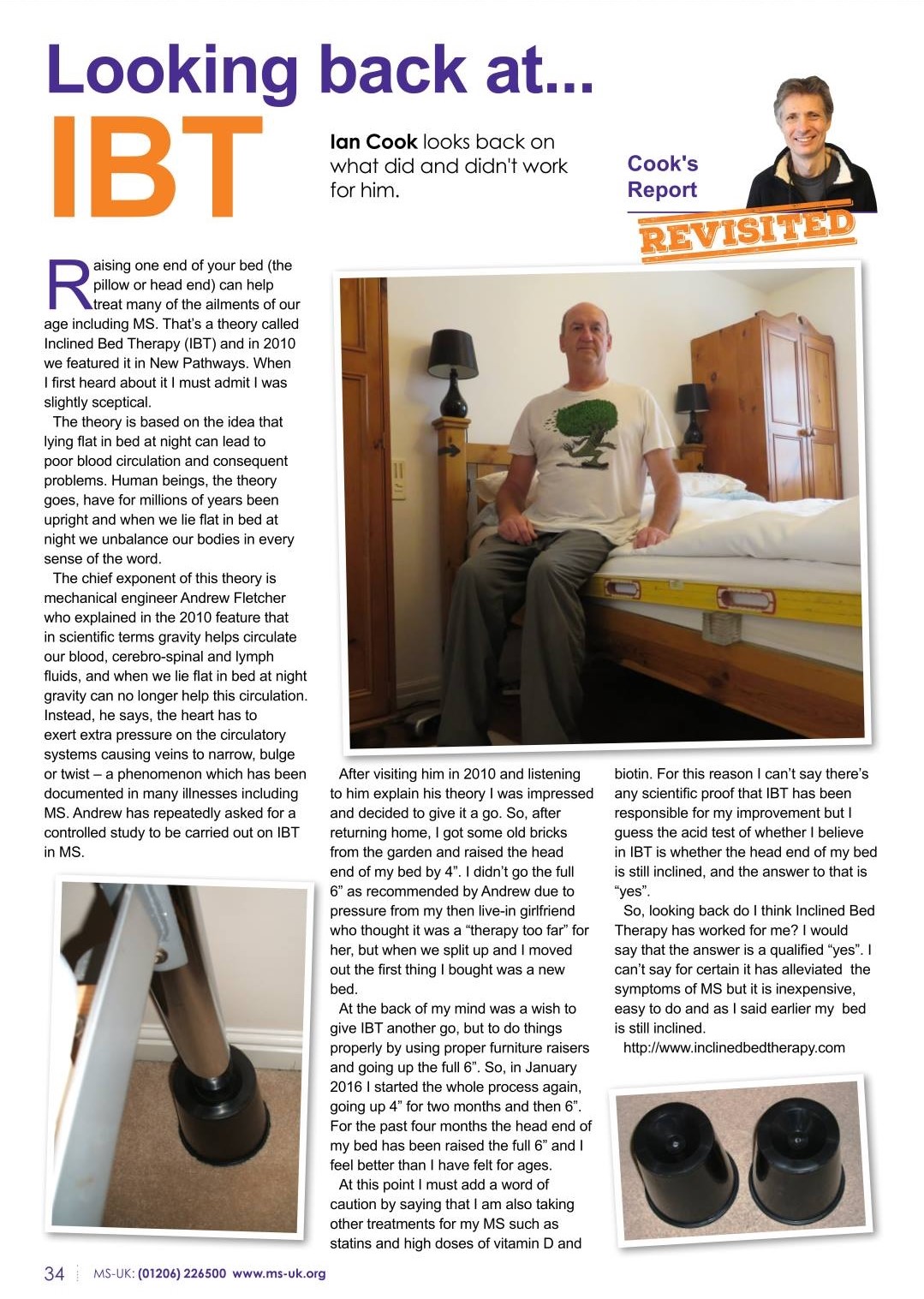

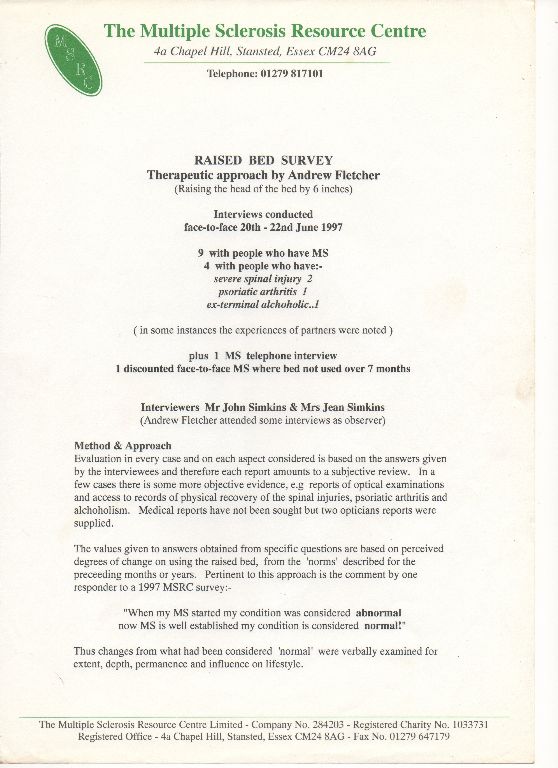
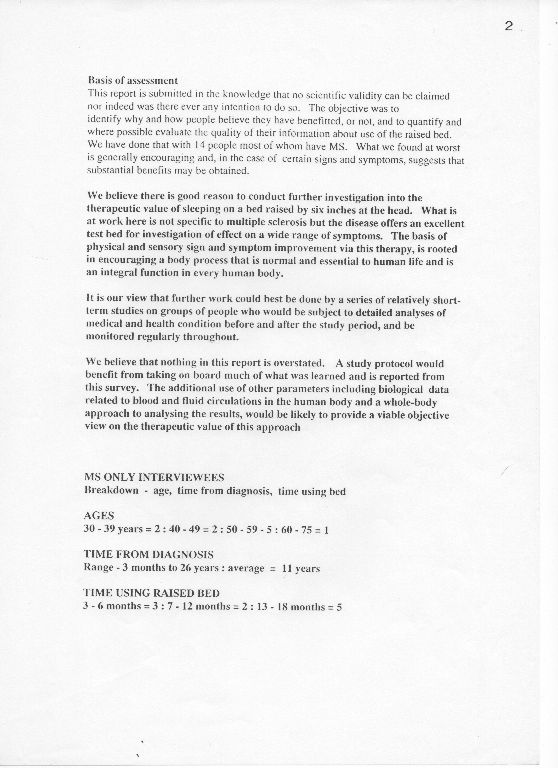
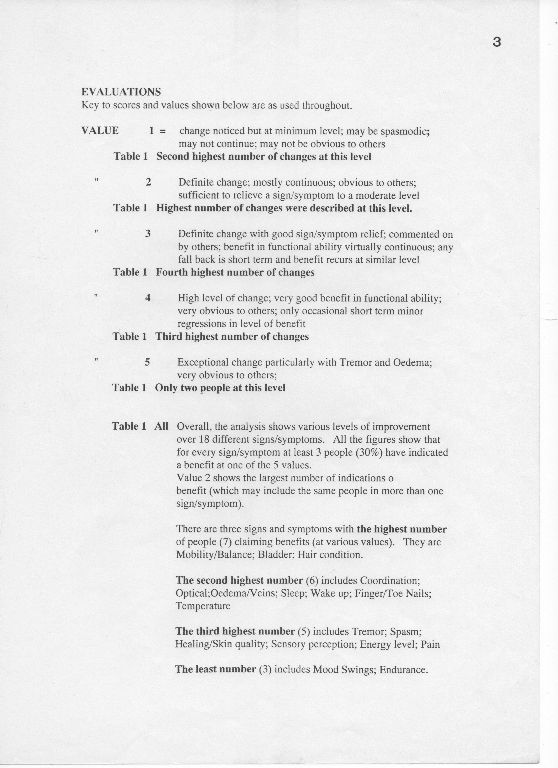
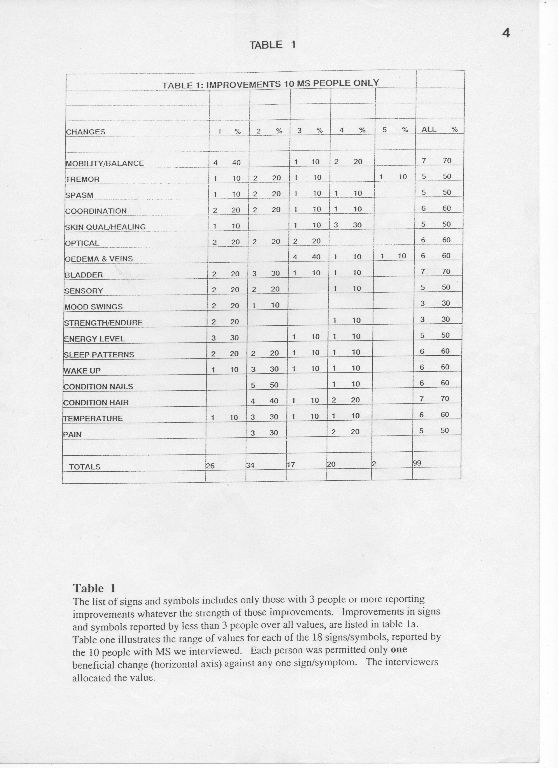
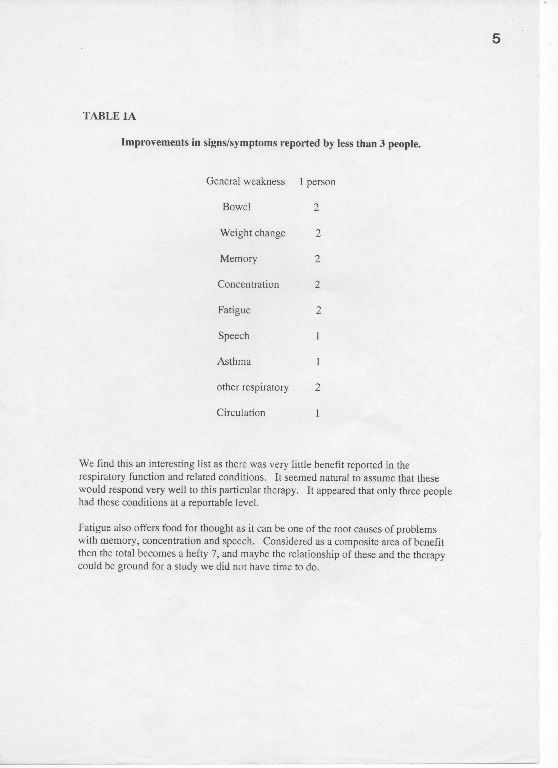
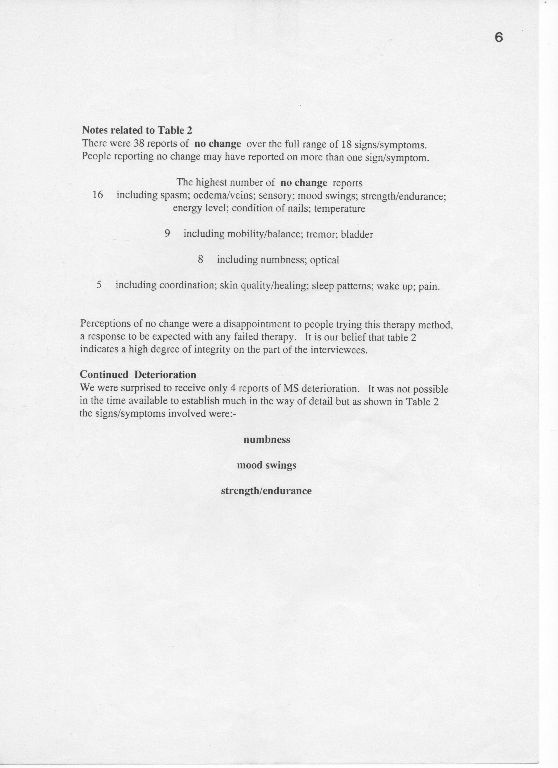
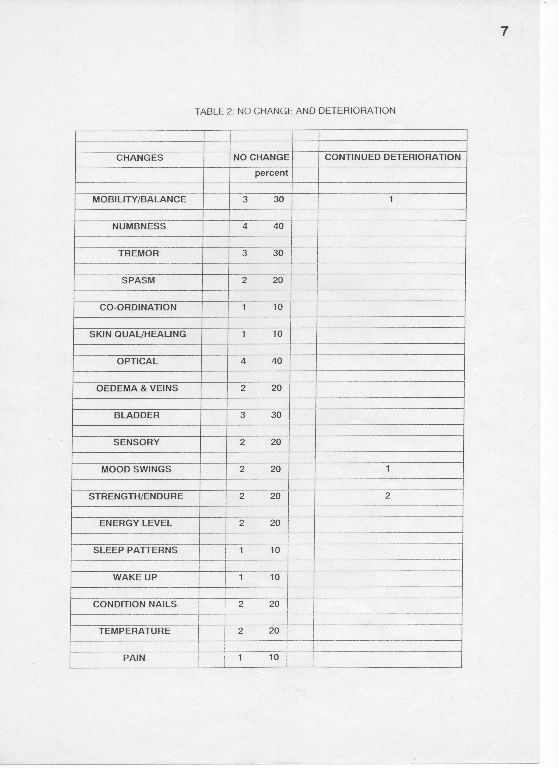
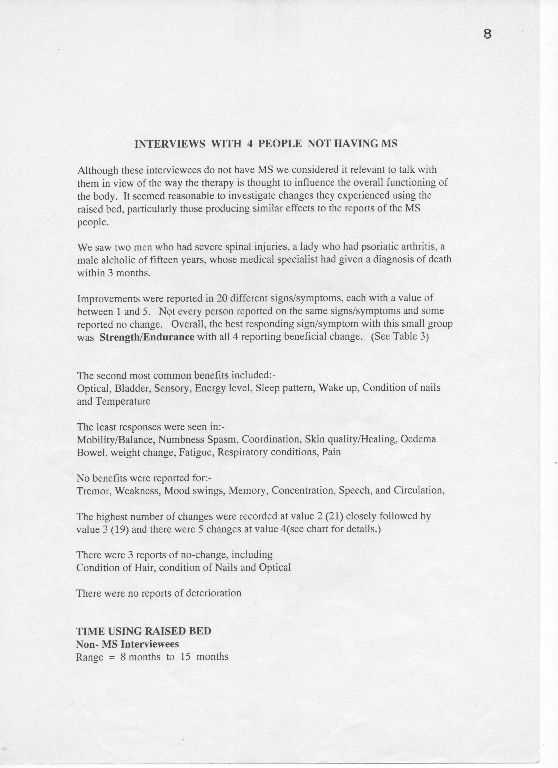
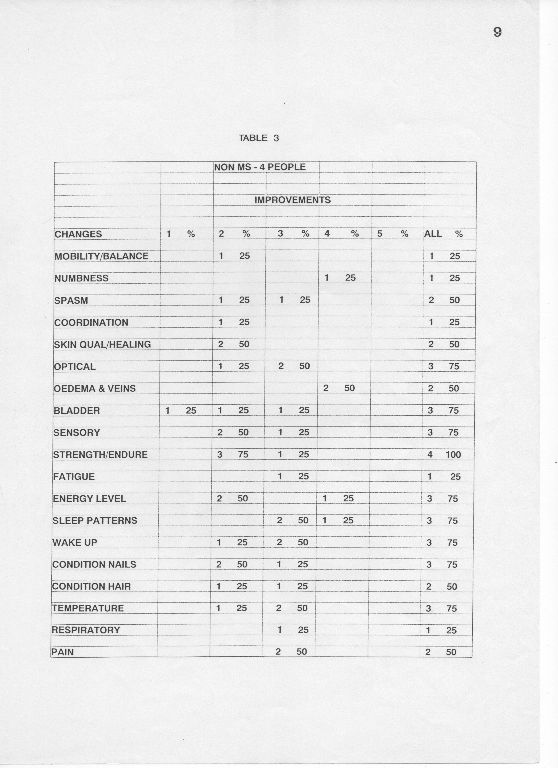

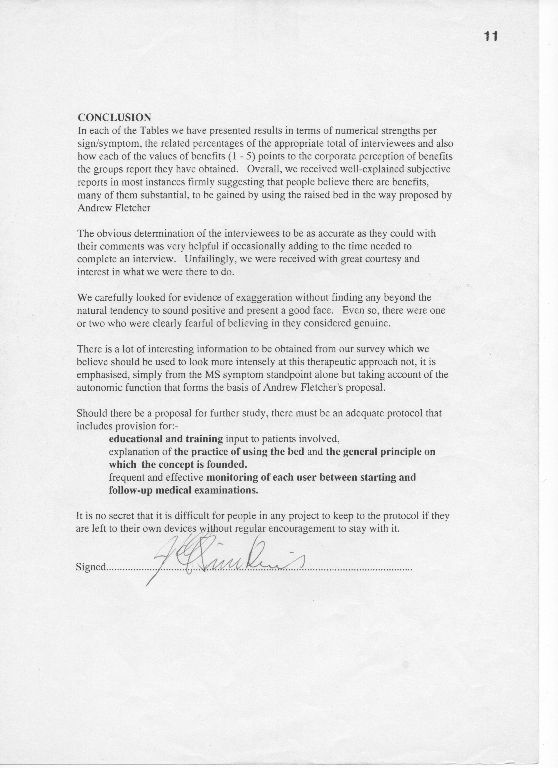
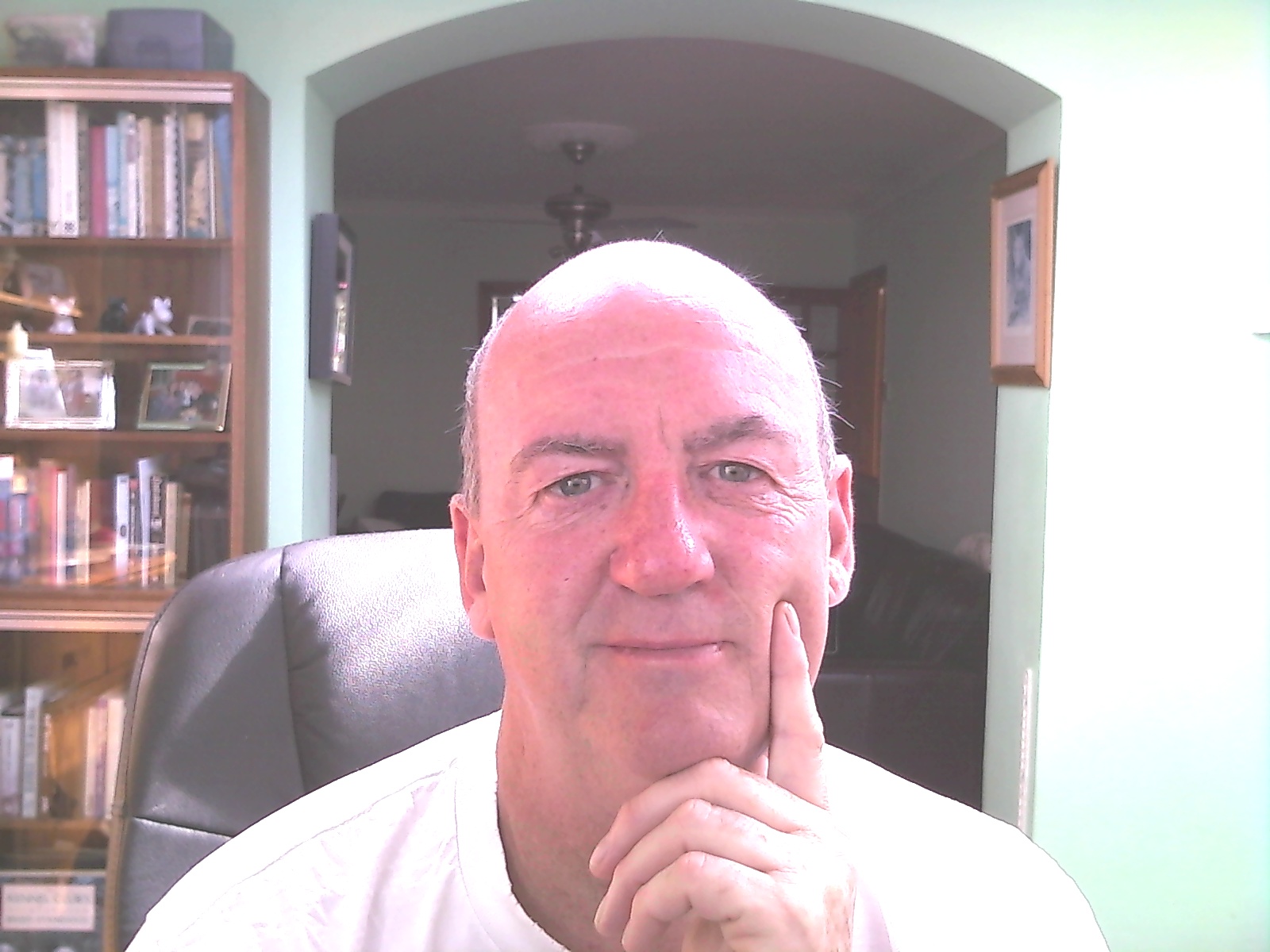 Listen Now:
Listen Now:
